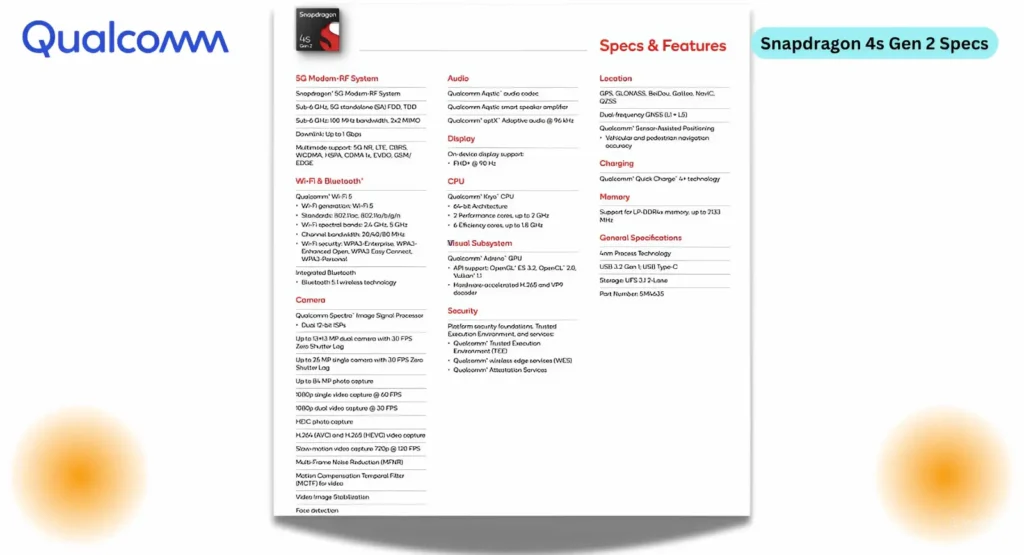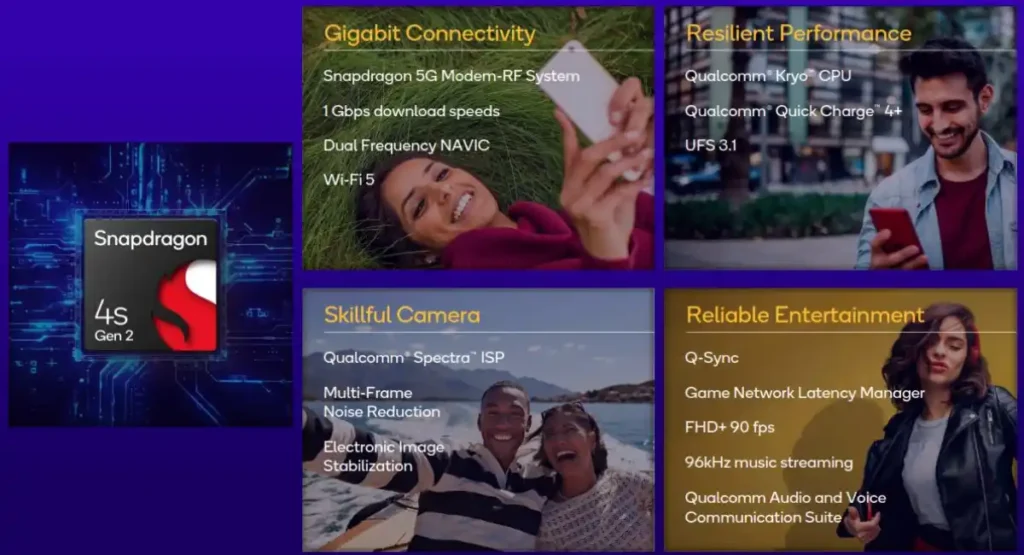Qualcomm will today announce a new chipset for its budget series of 5G smartphones under “Snapdragon for India” which will be called Snapdragon 4s Gen 2. The chipset’s launch page is yet to be published on the official site, but “Evan Blass” X (formerly of Twitter) linked the specs of the chipset yesterday. You might think that this is an improved chipset than last year’s predecessor Snapdragon 4 Gen 2, Umm not at all. Let’s take a look at the specs below.
Snapdragon 4s Gen 2 Specifications
The Snapdragon 4s Gen 2 chipset is an built on a 4nm technology. It features an Octa-core CPU (2x A78 up to @2.0GHz & 6x A55 up to @1.8GHz), and the smaller nanometer size means that it boasts improved battery efficiency. It also includes a Qualcomm Adreno GPU, but the version is unknown, which suggests it might be a bit behind.

The chipset supports a maximum FHD+ 90Hz display. In terms of cameras, it can support up to 84MP cameras and capture 1080p up to 60fps videos for recording. You can find all the specifications in the table below.
| Snapdragon 4s Gen 2 | Specs & Features |
|---|---|
| Process Node | TSMC 4 nm |
| CPU | Octa-core (2x A78 up to 2.0GHz & 6x A55 up to 1.8GHz) |
| GPU | Qualcomm Adreno |
| Display | FHD+ 90Hz |
| Camera | ISP Bit – 12-bit MP – Up to 84 MP |
| Max Video Capture | 720p @120fps & 1080p @60fps |
| RAM | Type – LPDDR4X Speed – Up to 2133 MHz |
| Storage | UFS 3.1 (2-Lane) |
| Connectivity | 5G Modem – 3GPP Release 17 5G (Download speed to 1 Gbps) Wi-Fi – 5 (802.11 a/b/g/n/ac) Bluetooth – 5.1 |
| USB | USB Type-C 3.2 Gen 1 |
| Others | Qualcomm aptX Adaptive Audio for 96kHz, Dual-frequency GPS with NavIC L1+L5 & NFC Support |
| Part Number | SM4635 |
This chipset can play videos at a maximum resolution of 1080p at 60fps and supports video codecs like H.264, H.265, and VP9. It also supports APIs like OpenGL ES 3.2, OpenCL 2.0, and Vulkan 1.1. To ensure long-lasting battery life, it features Qualcomm Quick Charge 4+ technology and 40W fast charging support, enabling you to charge up to 50% battery in just 15 minutes.
A Little Comparison Between 4s Gen 2 and 4 Gen 2
Observing Qualcomm’s naming conventions, we notice that the “s” series chipsets are downgraded versions compared to their predecessors. This is not unusual. Looking at the CPU speed of the 4s 2, we see that both performance and efficiency core have been reduced, with clock speeds being 200 MHz lower than the previous 4 Gen 2. While the chipset’s 5G modem (3GPP Release 17 5G) is upgraded, the download speed has been lowered to 1 Gbps compared to the previous 2.5 Gbps.

There is also a downgrade in the camera department, where the maximum supported lens size has been reduced from 108 MP to 84 MP; however, video recording capabilities remain unchanged. The new chip supports a maximum of LPDDR4X up to 2133 MHz of RAM, compared to the previous LPDDR5 up to 3200 MHz. However, storage remains the same, with no changes.
| Comparison | Snapdragon 4s Gen 2 | Snapdragon 4 Gen 2 |
|---|---|---|
| Process Node | TSMC 4 nm | TSMC 4 nm |
| CPU | Octa-core (2x A78 up to 2.0GHz & 6x A55 up to 1.8GHz) | Octa-core (2x A78 up to 2.2GHz & 6x A55 up to 2.0GHz) |
| GPU | Qualcomm Adreno 613 | Qualcomm Adreno |
| Display | FHD+ 90Hz | FHD+ 120Hz |
| Camera | ISP Bit – 12-bit MP – Up to 84 MP | ISP Bit – 12-bit MP – Up to 108 MP |
| Max Video Capture | 720p @120fps & 1080p @60fps | 720p @120fps & 1080p @60fps |
| RAM | Type – LPDDR4X Speed – Up to 2133 MHz | Type – LPDDR5 Speed – Up to 3200 MHz |
| Storage | UFS 3.1 (2-Lane) | UFS 3.1 (2-Lane) |
| Charging | Quick Charge 4+ | Quick Charge 4+ |
| Connectivity | 5G Modem – 3GPP Release 17 5G Wi-Fi – 5 (802.11 a/b/g/n/ac) Bluetooth – 5.1 | 5G Modem – 3GPP Release 16 5G Wi-Fi – 5 (802.11 a/b/g/n/ac) Bluetooth – 5.1 |
| Download Speed | Up to 1 Gbps | Up to 2.5 Gbps |
| USB | 3.2 Gen 1 | 3.2 Gen 1 |
| Part Number | SM4635 | SM4450 |
Conclusion
The Snapdragon 4s Gen 2 chipset would be considered a good chipset if it were released in an affordable price range. The company claims it will be seen in budget series 5G smartphones, but we’ll have to wait and see how it performs when it hits the market. However, it remains to be seen how the chipset can be optimized for budget smartphones.
This chipset is not better than the 4 Gen 2 in any way, but it does show improvements over the 4 Gen 1 in a few areas, like the process node, storage support, and ISP. But it also falls short of 4 Gen 1 in some aspects. Considering that the new chipset is an improvement over the 4 Gen 1, we can imagine them in this hierarchy: Snapdragon 4 Gen 1 < Snapdragon 4s Gen 2 < Snapdragon 4 Gen 2.
What are your thoughts on the new chipset? Let us know in the comments below. If you had to choose between these three chipsets, which one would you pick? Don’t forget to share your choice!


